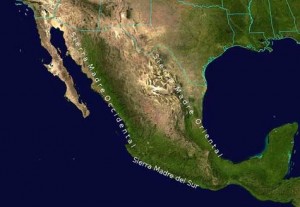When I grew up in Mazatlán, I’d hear people say, it’s better to live five years rich than a lifetime poor,” I was told by Daniel, who is studying law at a university in Mexico City. “Sometimes it would even be written on walls.”
In a different context this phrase might be promoting righteous work for personal progress. But since we were talking about the drug cartels in Mexico, I knew the meaning was shady — it is a justification for what decent men resort to while dancing to the seductive song of the drug trade.
As the drug war escalates, more civilians are caught in the crossfire. There have been innocent bystanders for decades, far from the gun battles in cities: the damage of drug production to the land, water and air. The environment has been the forgotten victim, raped and pillaged without notice.
Inland from Mazatlán and spanning several states is the Sierra Madre Occidental mountain range, one of the most ecologically diverse areas in North America. Mountain peaks up to 9,000 feet and deep valleys like the Copper Canyon set geographical limits for many temperate and tropical species — eagles and hawks soar above pine forests, green parakeets and boa constrictors roam the canyons.
The area has 200 species of oak trees and is world-renown for its endemic bird species such as the thick-billed parrot, which is in danger of extinction. Largely due to deforestation from logging and drug production, only 2 percent, or 300,000 acres, of old growth forest remain.

From the coastal state of Sinaloa to the border state of Chihuahua, the warm sunshine and mild winters of the Sierra Madre Occidental make it incredibly productive for drug cultivation. Its vast stretches of unpatrolled wilderness and direct distribution corridor into the U.S. (via Arizona, New Mexico and Texas) have made the Sierra Madre Occidental one of the world’s largest drug-producing regions for marijuana and opium.
Drug production is adding fuel to the destruction of the Sierra Madre Occidental. Deforestation is the No. 1 problem — 4 acres of forest are clear-cut on average to produce 1 acre of crop. The result is habitat destruction, emission of greenhouse gases and erosion that fills creeks with silt. Fertilizers and herbicides are used in excessive quantities, which poison and deplete the land and waterways.
Drug enforcement, meanwhile, can worsen problems. The threat of police raids pushes growers to do short crop cycles and relocate often. Police raids push producers deeper into the forest, increasing clear-cutting, without actually reducing supply levels. Plus, a common drug enforcement tactic is aerial crop spraying, which disperses vast quantities of herbicides into an area.
The logging industry, the primary driver of deforestation, has ties to drug organizations. Drug producers need access roads to expand their operations, which encourages illegal logging to clear areas for cultivation. Legitimate logging companies are often used to launder money earned in the drug trade.
Also on Miller-McCune.com, research suggests being aware of one’s environmental footprint could cause an ecological backlash.
The disposal of toxic chemicals from drug processing is another growing problem. The refinement of poppy flowers into opium and heroin is a highly toxic process that uses considerable amounts of chemicals such as sulfuric and hydrochloric acids, solvents like acetone and kerosene, and bases such as ammonia. This cocktail ultimately gets dumped in rivers or buried underground – a threat to humans, animals and plants.
This problem is similar to the unregulated toxic dumping by clandestine methamphetamine laboratories in the U.S. The Economist reported that from 2000 to 2002, the number of methamphetamine laboratories uncovered in the U.S. rose from 8,971 to 15,353. Every kilogram of meth product creates 7 kilograms of carcinogenic waste. The popularity of meth is causing a surge in illegally disposed chemicals throughout American cities.

The Sierra Madre Occidental is home to the Tarahumara, a group of indigenous people that has avoided colonization for centuries. The Tarahumara are renown for their extensive knowledge of the medicinal uses of plants, many of which are still finding application in modern Western medicine. Drug operations aggressively displace native Tarahumara Indians and pressure them into cultivating marijuana and poppy fields. This has been accentuated by drought; last year’s drought in Mexico caused the failure of corn crops, sometimes forcing subsistence growers into production of cash crops.
One of the most fearless men in the region was the late Edwin Bustillos, a part-Tarahumara who fought for the rights of indigenous communities in the Sierra during the ’80s and ’90s. Through his organization, Casmac, Bustillos helped communities earn income from alternatives to logging and drug production. His lack of cooperation with local drug cartels — which often purchase cooperation by placing politicians and police officers on the payroll — did not earn many friends. He barely survived three attempts on his life and sustained serious injuries. Bustillos came very close to reaching his goal of creating a biosphere reserve in the Sierra Madre and was recognized for his work by receiving the 1996 Goldman Environment Prize.
The drug-use debate has historically focused on health and crime. However, an increasing awareness of the environmental dimension of drugs is growing. According to Julia Buxton, author of The Political Economy of Narcotics: Production, Consumption, and Global Markets, the improved enforcement technologies of aerial surveillance and remote sensing over the last two decades has provided graphic evidence of land degradation in drug-producing areas. The environmental dimension was first given serious consideration in 1986, when Jamaica’s floods were attributed to deforestation from the extensive clear-cutting of cannabis cultivation; then-Prime Minister Edward Seaga used this to bolster support for a U.S.-led drug campaign on their island.
The Drug Destruction of Mexico, Part I
Arriving in Mexico’s mainland, our ecological blogger is brought face-to-face, almost literally, with Mexico’s cartel-driven politics. Read about it here
Drug enforcement has traditionally focused on reducing supply, with very limited results. In terms of demand (convincing drug-users to abstain), a shift has occurred. Whereas drug users dismiss violence abroad as “far away” and health impacts as “exaggerated,” deforestation is now globally recognized as a contributor to climate change and biodiversity loss. In short, the environment is a global issue, which measures up to the global problems of drug trafficking.
Nowhere is this environmental link more pronounced than in the cocaine production of the Andean countries — Colombia, Peru and Bolivia. “Each line of cocaine sniffed destroys 4 square yards of rainforest,” said Colombian Vice President Francisco Santos, representing a campaign called Shared Responsibility. People may drive a hybrid, recycle and worry about global warming, yet still not realize their night of partying can destroy 4 square yards (or more)of rainforest.
This November, voters in California may decide to legalize marijuana. Proponents say that the problems of supply (violence, corruption, ecological destruction) and demand (health) can be dealt with more effectively if the drug is regulated. Opponents say that putting marijuana on the same level as alcohol will increase drug use.
The debate is difficult because both sides are probably correct. In a world where people need to escape the disenchantment of city life by getting high, where living five years rich is better than a lifetime poor, and our environmental and social fabric is disintegrating as a consequence, I wonder: For how much longer will our society tolerate self-destruction?




